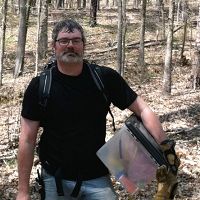Hayes et al., 2011
Critical zone weathering in the southern Sierra Nevada and Laramie Mountains imaged by seismic tomography.
Hayes, J.L., Holbrook, W.S., Riebe, C.S. (2011)
Fall meeting, American Geophysical Union, December 2011. Abstract H41D-1059.
-
Shale Hills, Sierra, INVESTIGATOR, COLLABORATOR
-
Boulder, Calhoun, Eel, Reynolds, Sierra, COLLABORATOR
-
Sierra, INVESTIGATOR
Abstract
Near-surface variations in seismic velocity reflect differences in physical properties such as density and porosity, which in turn reflect differences in alteration of parent material by exposure to water and biologic activity. Here we present tomographic analysis of the extent of weathering from seismic refraction experiments at two areas underlain by granite: the Southern Sierra Critical Zone Observatory (SSCZO) in the fall of 2010 & 2011 and the Laramie Mountains in the spring of 2010. A 48-channel geophone array and hammer source was deployed in both surveys. In both areas seismic velocities suggest that weathering has progressed to depths of 10 m or more. When coupled with geochemical measurements of the degree of regolith weathering, these depths imply that the potential for subsurface water storage in regolith may be a larger component of the water budget than previously thought at the SSCZO. The velocity of granite bedrock was determined independently in both studies to be ~4 km/s by seismic experiments directly on outcropping granite. Two other ranges of seismic velocities seem consistent between the studies: a saprolite layer of chemically altered but still intact rock (2-4 km/s) and a regolith layer more altered than the underlying saprolite layer (<2 km/s). Using these parameters we tested hypotheses in two different granite-weathering environments. In the SSCZO a velocity-depth profile that crosses a water-saturated meadow and an adjoining forest reveal relatively low gradients in the first ten meters beneath the forest (0.75 km/s per 10 m) and higher gradients beneath the meadow (3 km/s per 10 m). From these observations, we hypothesize that the saturated meadow may provide a reducing environment that inhibits chemical weathering relative to better-drained, more oxidizing conditions in the forest. In the 1.4 Ga Sherman batholith of the Laramie Mountains we observe isolated outcrops of Lincoln Granite within the Sherman Granite. Two 0.5 km profiles were shot parallel across a forested drainage valley. The velocity-depth images of these profiles show that the thickness of weathered material decreases in the drainage valley. We hypothesize that the outcropped granite is being exhumed as erosion removes a mantle of previously weathered material.
Citation
Hayes, J.L., Holbrook, W.S., Riebe, C.S. (2011): Critical zone weathering in the southern Sierra Nevada and Laramie Mountains imaged by seismic tomography. Fall meeting, American Geophysical Union, December 2011. Abstract H41D-1059. .
Explore Further



